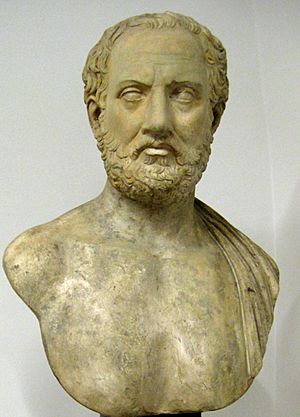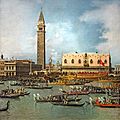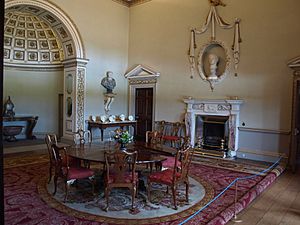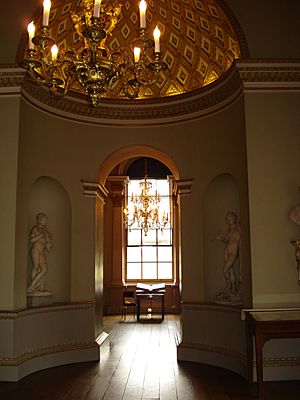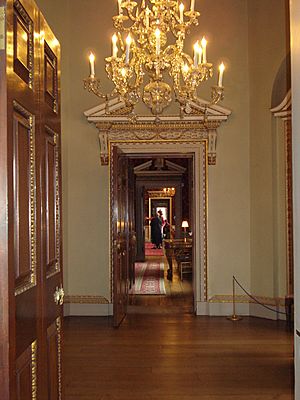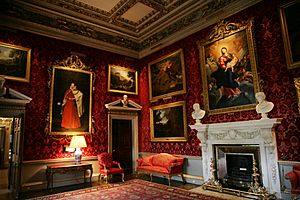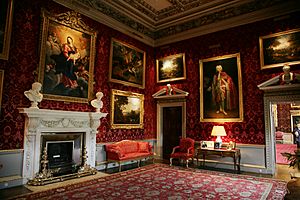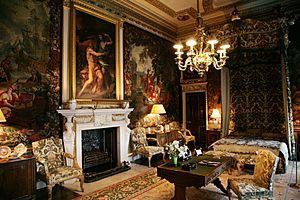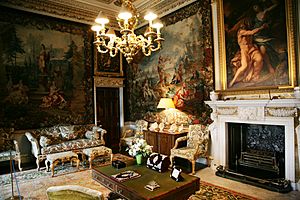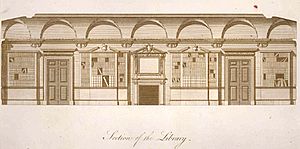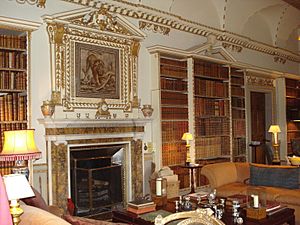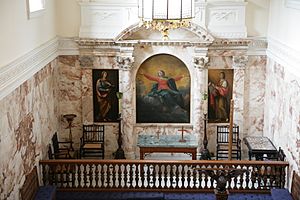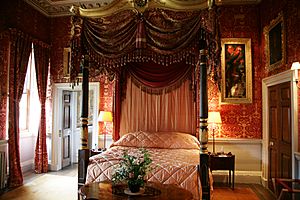Art collections of Holkham Hall facts for kids
The art collection of Holkham Hall in Norfolk, England, is very special. It was put together by the first owner, Thomas Coke, who designed his house around the art. He bought most of the pieces during his "Grand Tour" of Italy from 1712 to 1718. A Grand Tour was a long trip across Europe that young, wealthy people took to learn about art, history, and culture. Later, more art was bought by Matthew Brettingham the younger between 1747 and 1754 to complete the collection.
The house itself was a team effort. Thomas Coke, Richard Boyle, 3rd Earl of Burlington, and William Kent worked together on the design. Matthew Brettingham the elder was the architect who managed the building work. Holkham Hall was built from 1736 to 1764, and the inside was finished in 1771.
The house has a main block called the corps de logis where the grand "state rooms" are. These are on the first floor, also known as the piano nobile. Around this main block are four wings: one for the family, one for guests, a chapel wing, and a kitchen wing. If all the doors are open, you can see from one end of the house to the other, a distance of 344 feet (105 m)! The family wing was designed for everyday living.
The art and sculptures were placed very carefully. Everything was planned to look balanced and harmonious. Sometimes, a sculpture of a wild satyr (a mythical creature) might be placed opposite a statue of Athena, the goddess of wisdom. This creates interesting connections and contrasts in the stories they tell. In one room, you can look at paintings of landscapes and then look out the window at a real Landscape garden that was inspired by those very paintings.
The collection includes sculptures, paintings, mosaics, books, and old drawings. One famous item was a notebook by Leonardo da Vinci, called the Codex Leicester, which was sold in 1980.
Contents
Sculpture Collection
The collection of 60 Ancient Roman marble sculptures is one of the best in any private home. It includes life-size and larger-than-life statues and busts. You can see gods like the Twelve Olympians, characters from Greek mythology, ancient Greek philosophers, and important Romans. Most of these sculptures have been carefully repaired. The full-length statues are mainly in the Statue Gallery, while busts are found in many of the grand rooms.
Matthew Brettingham the Younger sent the first group of sculptures from Rome in 1749. It was hard to get permission to export some, like the statue of Isis. So, the last sculptures didn't arrive until 1754.
Some of the most impressive sculptures are:
- The bust of Thucydides, a famous Greek historian, made around 100–120 AD from Carrara marble. It's a very strong and realistic portrait.
- The goddess Artemis/Diana, from 190–200 AD. This was Thomas Coke's most expensive purchase, costing about £250 in 1717. She is shown holding a bow and reaching for an arrow.
- Marsyas, from 180–190 AD, a copy of an ancient Greek statue. This bearded figure leans on a tree stump with a lion skin.
- The Empress Livia, from the mid-1st century AD. She is shown in a long dress, holding a bunch of wheat.
- The god Poseidon/Neptune, from the late 1st to early 2nd centuries AD. He holds a trident and has thick, curly hair and a beard.
Many sculptures were bought by Thomas Coke on his Grand Tour (*), and others by Matthew Brettingham the younger (#).
Famous Roman Statues
- The Statue Gallery: Features Satyrs, Meleager#, Marsyas#, Poseidon/Neptune#, Apollo*, Dionysus/Bacchus#, Artemis/Diana*, Aphrodite/Venus#, Athena/Minerva#, and Demeter/Ceres#.
- The North Tribune: Includes Isis#, Livia#, and an unidentified man wearing a toga*.
- The Marble Hall: Has statues of Septimius Severus# and Julia Mamaea*.
Roman Busts (Heads)
- The Marble Hall: A bust of Roma.
- The Statue Gallery: Busts of Cybele*, Lucius Cornelius Sulla#, Thucydides#, Lucius Junius Brutus#, and Pseudo-Seneca#.
- The North Tribune: Emperor Philip as a youth# and Faustina the Elder#.
- The South Tribune: Hadrian#, Julia Mamaea#, Marcus Aurelius*, Gallienus#, and Geta#.
- The North Dining Room: Aelius Verus# and Juno#.
- The Saloon: Hera/Juno#.
- Private Rooms: Zeus/Jupiter*, Artemis, Salonina#, Nerva*, Plato#, Caracalla#, Gordian III#, and Maecenas#.
Other Roman Sculptures
- The Statue Gallery: A marble relief of Julius Caesar#.
- The South Vestibule: Ash Altar of Caius Calpurnius Cognitus* and the Cinerarium of Petronius Hedychrus*.
Post-Roman Sculptures
- The Marble Hall has plaster copies of famous sculptures like Apollo and Flora. It also has marble busts of important figures like Thomas Coke.
- The Drawing Room: Marble copies of busts of Marcus Aurelius and Caracalla.
- The South Dining Room: Four plaster busts.
- The South Vestibule: Plaster casts of statues like Dancing Faun and Apollo Belvedere.
- The Long Library: A marble bust of Alexander Pope and plaster copies of busts of Venus and Cybele.
- The Classical Library: Six plaster busts.
- Private Rooms: Marble copies of ancient busts, including Homer and Alexander the Great.
- The Corridor linking the Guest Wing to the North Tribune: Plaster casts of Venus de' Medici and Apollino.
Paintings Collection
The current Earl of Leicester has put most of the paintings back where they were originally meant to be. However, three paintings are no longer at Holkham. Titian's Venus and the Lute Player was sold in 1931. Two other important paintings, Continence of Scipio by Chiari and Coriolanus by Pietro da Cortona, are also gone. These lost paintings were very important to Thomas Coke's original plan because they showed stories about using power wisely or badly.
-
Treisani's Thomas Coke, Earl of Leicester
Here are some of the paintings you can see in different rooms:
- The Drawing Room has eleven paintings. Above the fireplace is Madonna in Gloria by Pietro da Pietri. There are also two paintings by Melchior d'Hondecoeter showing fighting birds, which are actually allegories (symbolic stories) about wars. You can also see landscapes by Gaspar Poussin and Claude Lorraine.
- The Saloon has eight paintings. In the center of the west wall is Rubens' The Return of the Holy Family. On the east wall is van Dyck's Duc D'Arenberg on Horseback, which Thomas Coke bought in Paris.
- The South Dining Room has eleven paintings. Above the fireplace is Thomas Gainsborough's portrait of Coke of Norfolk. Other works include Joseph and Potiphar's Wife by Guido Reni and a portrait of Sir Thomas More.
- The Landscape Room has 22 paintings, mostly landscapes. These include works by Gaspar Poussin and Claude Lorraine.
- The Green State Bedroom has five paintings, all ordered by Thomas Coke. Above the fireplace is Jupiter caressing Juno by Gavin Hamilton.
- The Green State Dressing Room has smaller paintings by artists like Jacopo Bassano.
- The North State Dressing Room: Features a copy of Michelangelo's Florentines surprised by the Pisans while bathing.
- The North State Bedroom: Has portraits by Jonathan Richardson, including one of Lady Margaret Tufton and Thomas Coke.
- The Chapel: Above the altar is Guido Reni's The Assumption of the Virgin. Other paintings include The Adoration of the Magi by Mattia Preti.
- The Classical Library: Has a 1717 portrait of Thomas Coke by Francesco Trevisani.
- Lady Leicester's Sitting Room: Features Canaletto's View of the Palace of St Mark, Venice and four views of Rome by Gaspar van Wittel.
- The private rooms contain many portraits, including those by Andrea Casali and Rosalba Carriera.
- The Guest Wing: Includes a Parrot painting by Frans Snyders, and works by Joshua Reynolds.
- The Kitchen: Has a large portrait of a servant.
Paintings by School
Here's a list of some of the artists and their schools (styles) found at Holkham:
- Dutch School: Melchior d'Hondecoeter, Gaspar van Wittel.
- English School: Peter Lely, Thomas Gainsborough, Joshua Reynolds, Jonathan Richardson.
- Flemish School: Jan Frans van Bloemen, Anthony van Dyck, Marcus Gheeraerts the Younger, Peter Paul Rubens, Frans Snyders.
- French School: Gaspard Dughet (Gaspar Poussin), Claude Lorraine, Claude Joseph Vernet.
- German School: Hans Holbein the Younger (school of).
- Italian School: Jacopo Bassano, Pompeo Batoni, Canaletto, Annibale Carracci, Rosalba Carriera, Andrea Casali, Giuseppe Bartolomeo Chiari, Giovanni Battista Cipriani, Sebastiano Conca, Pietro da Cortona, Luca Giordano, Giovanni Francesco Grimaldi, Giovanni Lanfranco, Andrea Locatelli, Bernardino Luini, Carlo Maratta, Parmigianino, Pietro da Pietri, Mattia Preti, Andrea Procaccini, Guido Reni, Cristoforo Roncalli, Salvator Rosa, Andrea Sacchi, Bastiano da Sangallo, Agostino Scilla, Titian (style of and school of), Francesco Trevisani, Giorgio Vasari, Domenico Zampieri, Francesco Zuccarelli.
- Scottish School: Gavin Hamilton.
Books and Manuscripts
Thomas Coke bought many books and manuscripts during and after his Grand Tour. In 1719, he bought the famous 'Codex Leicester', a notebook by Leonardo da Vinci. He also bought Greek manuscripts and important books on architecture. He even hired a librarian named Domenico Ferrari.
The collection includes books by famous architects like Giacomo Leoni (Palladio's books) and Colen Campbell (Vitruvius Britannicus). Other interests of Coke included politics and music.
There are also many old documents about building the house and buying the collections. These include letters and architectural plans by William Kent.
- The Long Library: Holds 2,000 of Thomas Coke's 10,500 books and manuscripts. Most are about Italy and the Renaissance.
- The North Tribune: Houses about 300 very large books, including architectural books.
- The Classical Library: Has 700 titles, including 209 incunabula (books printed before 1501). One special item is an illuminated manuscript of Virgil's Aeneid from around 1500.
- The Manuscript Library: Contains 558 literary, religious, and legal manuscripts from the 12th to 18th centuries. Some belonged to Sir Edward Coke, including documents related to the settlement of North America and a 15th-century copy of Magna Carta.
The Design of Holkham Hall
It's not known exactly when the idea for Holkham Hall's design first came about. It might have been during Thomas Coke's Grand Tour when he met William Kent and Lord Burlington. They traveled through Italy and saw the architecture of Andrea Palladio firsthand, especially his villas. Palladio's book, I Quattro Libri dell'Architettura (The Four Books of Architecture), explained his design ideas.
Holkham Hall's design was based on Palladio's villas, but it was made for an English country estate, not a summer home. In Palladio's villas, the family lived in the main block, and the wings were for farm use. At Holkham, the grand State Rooms with the best art are in the center, and the wings are for daily life and services.
The design of Holkham Hall was also influenced by Inigo Jones's work. Lord Burlington bought Jones's architectural drawings, which were later published. Features like ceilings with deep plaster beams and grand fireplaces in the Drawing Room show Jones's influence.
Another important book was Antoine Desgodetz's Les edifices antiques de Rome (1682). This book had detailed drawings of ancient Roman buildings. Many architectural details at Holkham, like the columns in the Marble Hall (based on the Temple of Fortuna Virilis) and the ceiling patterns (from the Pantheon), came from this book.
The Marble Hall itself was inspired by Palladio's ideas for a "Basilica" or court of justice, which he showed in his designs for a translation of Vitruvius's architectural book.
Holkham's design was also influenced by Houghton Hall, another grand Palladian house, and Chiswick House, designed by Lord Burlington and William Kent.
Influence of Holkham's Design
The building most influenced by Holkham Hall is Kedleston Hall. Matthew Brettingham the Elder, who worked on Holkham, was the first architect for Kedleston. Holkham's grand style, based on Roman public buildings, was becoming old-fashioned even before it was finished. Later, architects like Robert Adam brought in lighter, more modern "Neo-classical" designs, inspired by newly discovered Roman homes in Pompeii. Holkham's grand style was never repeated in a British house in the same way.
Building and Decoration of Holkham Hall
The records at Holkham show all the materials and costs for building the house. It cost nearly £90,000 to build and decorate, plus another £8,562 for furnishings.
Key Dates in Construction
- 1707: Thomas Coke inherits the estate.
- 1712–18: Thomas Coke buys art during his Grand Tour.
- 1726: First designs for the house are made.
- 1734: Building begins with the Family Wing.
- 1738–41: Family wing completed.
- 1740: Main part of the house (Corp de Logis) started.
- 1744: Thomas Coke becomes Earl of Leicester.
- 1747–54: Matthew Brettingham the Younger buys art in Italy.
- 1748: William Kent dies.
- 1753: The Statue Gallery and North Dining Room get their windows.
- 1754: Statues and pictures are installed.
- 1755: Important changes are made to the Marble Hall's design.
- 1756: The Kitchen wing is finished.
- 1759: Thomas Coke dies. James Miller takes over as architect.
- 1765: Building of the house is complete.
- 1771: Lady Leicester pays for the last furniture.
- 1773: The final artworks are installed.
Description of Major Rooms
- The Marble Hall: This is the grandest room, almost 50 feet (15 m) high. It has a large curved section (apse) and a colonnade of eighteen tall, pink-veined Derbyshire alabaster columns with white marble tops. The floor is white marble. An inscription above the main entrance tells the story of Thomas Coke building the house.
- The North Dining Room: This room is a perfect cube, 27 feet (8.2 m) on each side. It has a large curved section (apse) and two fireplaces made of Sicilian Jasper and white marble, with carvings from Aesop's Fables. The room is mostly white with some gold details.
- The Statue Gallery: This long room is 105 feet (32 m) long. It has two octagonal sections (tribunes) with domes, connected by arches to the main rectangular room. It's filled with statues and busts. The walls are a very pale grey with white and gold details.
- The Drawing Room: This room is 20 by 30 feet (9.1 m). The fireplace is made of white marble. The walls are covered in patterned red velvet, and the plaster ceiling has nine rectangular sections with rich decorations.
- The Saloon: This large room is 28 by 40 feet (12 m). It has a very tall, decorated ceiling. The walls are covered in red patterned fabric. Two side tables have tops made from ancient Roman mosaics from Hadrian's Villa.
- The South Dining Room: Similar in size to the Drawing Room, this room has a white marble fireplace with a blue Lapis Lazuli panel. The walls are covered in red velvet.
- The Landscape Room: This room is 20 feet (6.1 m) square. The fireplace has colorful marble panels. The walls are covered in red Damask fabric, and the ceiling has a geometric pattern.
- The Green State Bedroom: This bedroom is 32 by 20 feet (6.1 m). It has a white marble fireplace with carved figures. The walls are covered with beautiful tapestries showing the four continents. The bed and furniture have their original colorful velvet upholstery.
- The Long Library: This was one of the first rooms finished, in 1741. It's 54 by 18 feet (5.5 m). It has a yellow marble fireplace with a mosaic of a lion fighting a leopard above it. The room is filled with built-in bookcases designed by William Kent.
- The Chapel: This room rises through two floors. It has a cedar-wood gallery for the family. The lower walls are covered in alabaster, and the upper walls are white plaster with paintings.
- The Kitchen: This large kitchen is 24 by 54 feet (16 m). It has cast iron cooking ranges and a large collection of copper pots and pans. This kitchen hasn't been used since 1939.


